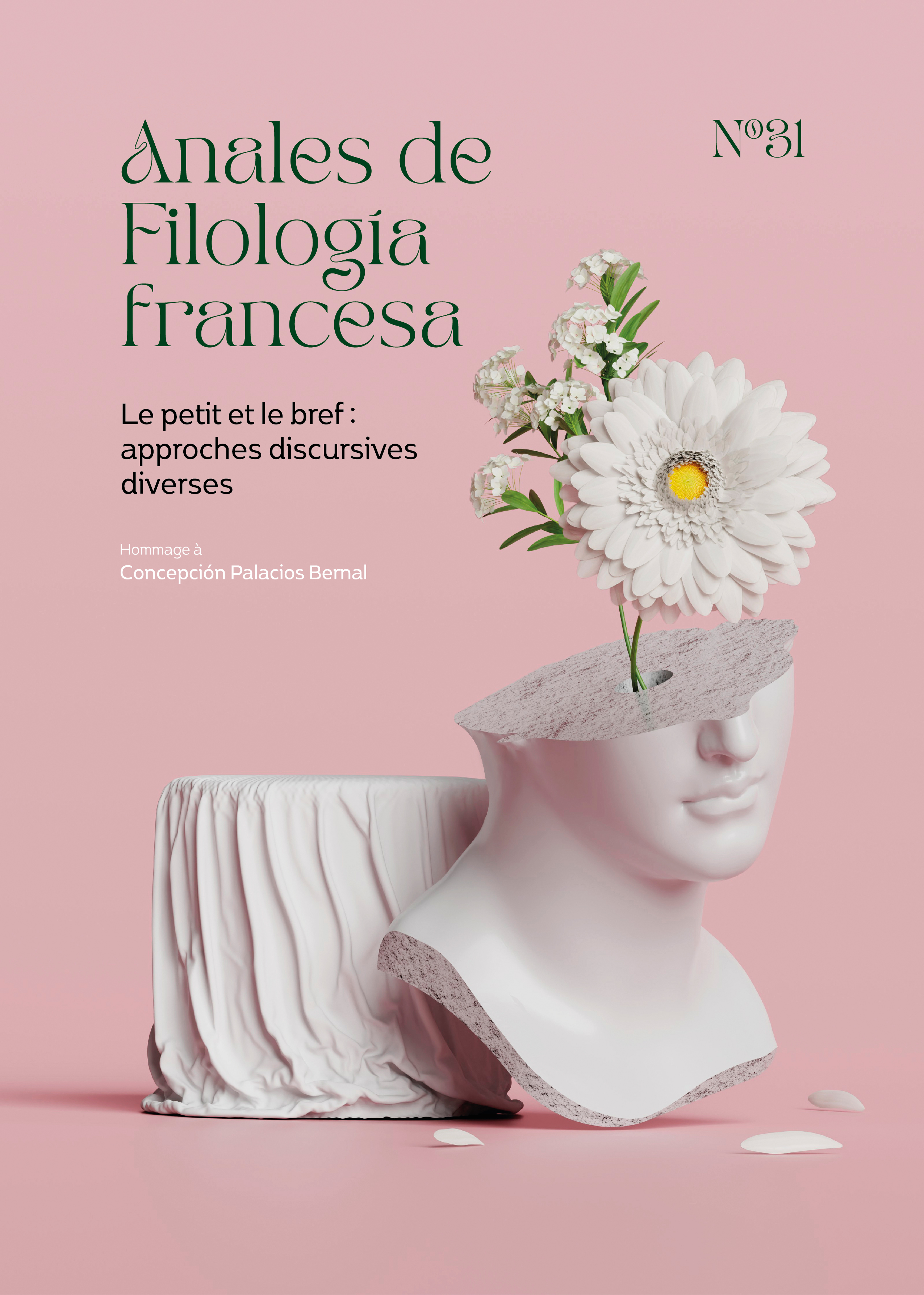Membra disiecta. La découverte d’un fragment inconnu du Roman de la Rose dans la Bibliothèque universitaire de Salamanque
Résumé
The aim of this article is to report our recent discovery of a manuscript fragment of the Roman de la Rose, copied in the 14th century and preserved in the front and back covers of a book printed in France in the 16th century, which is now part of the collection of the Biblioteca General Histórica of the University of Salamanca (Spain). These are two sheets of paper, probably separated from an old bifolium, which, once dismembered from the original codex, served as a binding element for the printed book. Our aim, in this first paper, will be to describe the fragmentology methodology that we will follow in the near future for the analysis of the membra disiecta. A palaeographic, codicological and philological study of the fragment will open up the possibility of investigating the possible existence of other scattered fragments of a dismembered codex, which may have survived as part of the binding of other 16th-century books.
Téléchargements
-
Résumé374
-
PDF461
Références
ALTURO, Jesús. 2012. « Les études sur les fragments manuscrits en Espagne: bilan et considérations diverses », in Revista de História da Sociedade et da Cultura, nº 12, 79-112.
ARLIMA = Archives de Littérature du Moyen Âge : <https://www.arlima.net> [25/06/2023].
Bongarsiana Codices. Berne : Bibliothèque de la Bourgeoisie de Berne : <https://www.burgerbib.ch/fr/fonds-et-collections/bongarsiana-codices> [25/06/2023].
BORELLI, Marcela & Olga Soledad BOHDZIEWICZ. 2021. « El libro antiguo y la reutilización de manuscritos: relevamiento y catalogación de fragmentos manuscritos in situ en colecciones argentinas», in Palabra Clave (La Plata), nº 11(1), e135 : <https://doi.org/10.24215/18539912e135> [25/06/2023].
BOURDILLON, Francis William (1906 [1974]). The early editions of the Roman of the Rose. Genève, Slatkine Reprints.
DUBA, William & Christoph FLÜELER. 2018. « Éditorial. Fragments et fragmentologie », in Fragmentologie. Revue pour l’étude des fragments de manuscrits médiévaux, nº 1, 1-5.
Fragmentarium. Digital Research Laboratory for Medieval Manuscript Fragments. Fribourg : University of Fribourg : [25/06/2023].
Fragmentologie. Revue pour l’étude des fragments de manuscrits médiévaux (2018-2022) Fribourg : University of Fribourg : <https://www.fragmentology.ms/> [25/06/2023].
IGLESIAS-FONSECA, Josep Antoni. 2019. « “Instruments inútils o no importants per lo monastir”. En los márgenes de la codicología: fragmentos y membra disiecta », in Avenoza, Gema, Laura Fernández Fernández & M. Lourdes Soriano Robles (eds.). La producción del libro en la Edad Media: una visión interdisciplinar. Madrid, Silex, 247-467.
LANGLOIS, Ernest. 1914-1924. Le Roman de la Rose par Guillaume de Lorris et Jean de Meung. 5 vols. Paris, Firmin-Didot.
LANGLOIS, Ernest, 1910. Les manuscrits du Roman de la Rose. Description et classement, Lille, Tallandier ; Paris, Champion (Travaux et mémoires de l'Université de Lille. Nouvelle série, I. Droit, lettres, 7).
LIGNER, Anaïs. 2022. Membra disjecta del Roman de la Rose. Un fragmento en la Biblioteca General Histórica de la Universidad de Salamanca. Trabajo Fin de Máster, Máster en Patrimonio textual y humanidades digitales, curso 2021-2022, Universidad de Salamanca (España).
LLAMAS-POMBO, Elena. 2007. « Réflexions méthodologiques pour l’étude de la ponctuation médiévale », in Alexei Lavrentiev (dir.). Systèmes graphiques de manuscrits médiévaux et incunables français : ponctuation, segmentation, graphies (Actes de la Journée d’Étude de Lyon, ENS-LSH, 6 juin 2005), Collection « Langages » nº 3, Chambéry, Université de Savoie, 11-48.
LLAMAS-POMBO, Elena. 2010. « Marques graphiques du discours rapporté. Manuscrits du Roman de la Rose, XVe siècle », in Combettes, Bernard, Céline Guillot, Évelyne Oppermann-Marsaux, Sophie Prévost & Amalia Rodríguez Somolinos (éds), Le changement en français. Études de linguistique diachronique. Berne, Peter Lang, 249-269.
MOREAU, Brigitte. 1985. Inventaire chronologique des éditions parisiennes du XVIe siècle, 3. 1521-1530 : d’après les manuscrits de Philippe Renouard. Abbeville, Paillart.
MULLETT, Ruth. 2018. « In-situ manuscript fragments in the incunables of the Bodleian Library, Oxford: a fragmentarium case study », in Fragmentology, nº1, 111-120.
MUNDO I MARCET, Anscari Manuel. 1985. « Comment reconnaître la provenance de certains fragments de manuscrits détachés de reliures ». Codices manuscripti [Olim Codices manuscripti & impressi. Zeitschrift für Handschriftenkunde], nº 3-4, 116-123.
MUZERELLE, Denis (2002-2003). Vocabulaire codicologique. IRHT-CNRS, Comité International de Paléographie Latine : <http://www.palaeographia.org/vocabulaire/vocab.htm> [25/06/2023].
NICHOLS, Stephen & James M. BEALL. The Roman de la Rose digital Library, in Digital Library of medieval Manuscripts : <https://dlmm.library.jhu.edu/en/digital-library-of-medieval-manuscripts/> [25/06/2023].
WEINBURG, Bernard. 1949. « Guillaume Michel, dit de Tours. The Editor of the 1526 Roman de la Rose », in Bibliothèque d’Humanisme et Renaissance, nº 11 (1), 72-85.
Las obras que se publican en esta revista están sujetas a los siguientes términos:
1. El Servicio de Publicaciones de la Universidad de Murcia (la editorial) conserva los derechos patrimoniales (copyright) de las obras publicadas, y favorece y permite la reutilización de las mismas bajo la licencia de uso indicada en el punto 2.
2. Las obras se publican en la edición electrónica de la revista bajo una licencia Creative Commons Reconocimiento-NoComercial-SinObraDerivada 3.0 España (texto legal). Se pueden copiar, usar, difundir, transmitir y exponer públicamente, siempre que: i) se cite la autoría y la fuente original de su publicación (revista, editorial y URL de la obra); ii) no se usen para fines comerciales; iii) se mencione la existencia y especificaciones de esta licencia de uso.
3. Condiciones de auto-archivo. Se permite y se anima a los autores a difundir electrónicamente las versiones pre-print (versión antes de ser evaluada) y/o post-print (versión evaluada y aceptada para su publicación) de sus obras antes de su publicación, ya que favorece su circulación y difusión más temprana y con ello un posible aumento en su citación y alcance entre la comunidad académica. Color RoMEO: verde.










